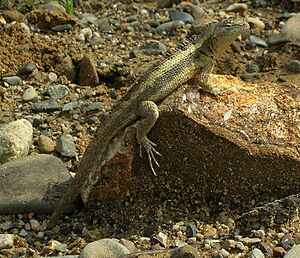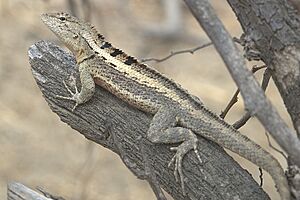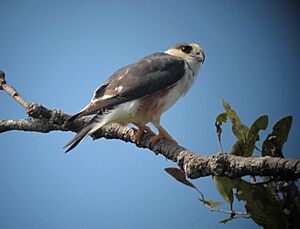Knobbed Pacific iguana facts for kids
Quick facts for kids Knobbed Pacific iguana |
|
|---|---|
 |
|
| Conservation status | |
| Scientific classification | |
| Genus: |
Microlophus
|
| Species: |
occipitalis
|
| Synonyms | |
|
|
The knobbed Pacific iguana (scientific name: Microlophus occipitalis) is a type of lizard. It belongs to the Tropiduridae family. This lizard is also known as a lava lizard, as it is part of the Microlophus group.
You can mostly find the knobbed Pacific iguana along the coasts of western Peru and Ecuador. These lizards live in many different places. They can be found on beaches, in lomas (green hills in dry areas), and even in deserts. They also like open spaces, rocky areas, or bushes.
Male and female knobbed Pacific iguanas look quite different. This is called sexual dimorphism. Males are much bigger than females. These lizards usually measure between 50 and 80 millimeters from their snout to the start of their tail. Males often have less color, while females can have red to white folds on their necks. These colors help them signal information to other lizards, especially during mating.
Like most other lizards, the knobbed Pacific iguana is cold-blooded. This means its body temperature changes with its surroundings. It warms itself by basking in the sun. This helps it keep its body at the right temperature.
Contents
Physical Features
The knobbed Pacific iguana is a small lizard. It usually measures about 50 to 80 millimeters long. This measurement is taken from the tip of its snout to the base of its tail.
Males and Females Look Different
Male and female knobbed Pacific iguanas have clear differences in their looks. This is called sexual dimorphism. For example, males usually do not have throat markings. Females, however, often have colors ranging from white to orange or red on their throats.
Males typically do not have much color. They usually only have black marks on their upper back. Both male and female iguanas are born with red throats. But after about a month, males lose this red color. Females can keep their red neck folds. These colors are important for females during reproduction and courtship. Also, males are generally much larger than females. They also tend to be more active and aggressive.
Where They Live
Knobbed Pacific iguanas mostly live along the coasts of western Peru and Ecuador. They can live in many different small environments. These include deserts, lomas, and beaches.
In the morning, they like open, sunny spots. During the middle of the day, they find shelter in bushes, fallen logs, or old buildings. At night, they hide between rocks. This helps them keep their body temperature steady.
These lizards are usually not very territorial. You might find many males and females living in the same area. But if two large, aggressive males are in the same spot, one will usually leave. Smaller males might live near a large, aggressive male without problems.
Lizard Family Tree
The knobbed Pacific iguana belongs to the Microlophus group. This group is also known as the lava lizards. The knobbed Pacific iguana is most closely related to Microlophus habelii and Microlophus bivittatus.
About Lava Lizards
There are 24 different kinds of lava lizards. Most of them look very similar. All lava lizards also act alike. For example, they all do "push-ups" to show other lizards they are strong.
You can find all lava lizards either on the Galápagos Islands or along the Pacific Coast of South America. Different types of lava lizards rarely live in the same areas. Even though lava lizards are common overall, some specific types are considered vulnerable.
How Their Bodies Work
Staying Warm
Knobbed Pacific iguanas are most active from early morning until late afternoon (8 AM to 5 PM). Their body temperature is usually around 36.1 degrees Celsius. Males and females have similar body temperatures.
These lizards move to different spots throughout the day to control their body temperature. In the early morning, they are in open areas to get sunlight. Around noon, they find shade in bushes or wooded areas. At night, they cling to rocks or trees to stay warm. This is called thermoregulation.
Showing Dominance
While many females can be in the same place as a male, males often create a hierarchy. This means some males are more dominant than others. The most dominant male is usually the one who shows aggressive displays most often.
Dominant males often climb onto high spots, like a rock. From there, they do a series of "push-ups" with their front legs. They do three push-ups in a cycle, with a short pause between the first two and the third. The first push-up is usually deeper than the others. Smaller males will often lie flat in front of dominant males. This shows they are being submissive. Males use these actions to attract female mates.
What They Eat
Knobbed Pacific iguanas are insectivorous, meaning they mostly eat insects. Their diet includes ants, insect larvae, and other small creatures like hymenopterans (like bees and wasps), coleopterans (beetles), and orthopterans (like grasshoppers). They might also eat leaves and some fruits. What they eat can change depending on how much rain there is and the time of year.
Reproduction and Life Cycle
Mating Habits
Female knobbed Pacific iguanas have a mating season from December or January to May or June. The exact timing depends on the rainfall. They usually lay 2 to 5 eggs in a clutch.
Females become mature enough to reproduce within about a year. They typically have one successful year of laying eggs. Males also mature in about a year. However, males often wait another year before they become dominant. Being dominant gives them more chances to mate. When they mature, females are about 45-47mm long (snout to vent). Males are 50-55mm. As they grow older, they can reach 50-80mm.
Life Stages and Colors
As males get older, they develop a black area on their upper back. Females get throat colors that range from white to red. Both male and female iguanas are born with red throats. But males lose this red color after about 30 days. Females, however, can keep their throat colors.
These colors are important for signaling during mating. A female with a red throat is pregnant or has just given birth. A slightly red throat can mean she is about to lay eggs or has just given birth. A white throat means the female is not pregnant or is too young to mate. These color changes happen in cycles that last about 25-30 days. The throat quickly changes from white to red when a female is ready to lay eggs.
Red-throated females are more likely to reject males. They show rejection by arching their back, wagging their tail, extending their dewlap (a flap of skin under the throat), or hopping sideways. It is thought that pregnant females use these colors to avoid unwanted attention from males. This saves them energy and helps them avoid predators. Scientists have even tested this idea by painting females' throats from red to white.
Who Are Their Enemies?
Predators
Because they are small, knobbed Pacific iguanas are hunted by many birds. One of these birds is the Pearl kite. The knobbed Pacific iguana is a main food source for the Pearl Kite.
Parasites
Ticks are common parasites of the knobbed Pacific iguana. But not all iguanas are affected the same way. Lizards living in different places have different levels of parasites. These lizards live in many small environments, like forest floors or sandy beaches.
Iguanas living on the forest floor had many more parasites. Those on sandy beaches had far fewer. This might be because lizards can "swim" in the sand. They can rub their bodies on the sand to shake off parasites. Also, sandy beaches are hotter. Parasites do not survive as well in hot, dry places.
Protecting the Species
The knobbed Pacific iguana is listed as an animal of "least concern" by the IUCN. This means the species is not currently in immediate danger. However, it is important to remember that climate change and global warming could harm the knobbed Pacific iguana's habitat in the future. So, people should be careful to protect their environment.






